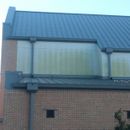What causes this mildew?
I am trying to understand what is causing the “mildew” striations in the attached image. I am an architect in Southern Louisiana and saw this happening on a local building (not one of mine) and I am trying to understand what can cause this issue, so that I can prevent this on any of my projects. A little background about the picture. The building is in hot-humid climate in southern Louisiana. The picture is taken on the north/west facade. It is a church with a large interior volume. Wall construction is probably cement Stucco with a membrane (not sure what type or perm) with dens glass sheathing, metal studs and probably batt insulation (not sure if it has a kraft facing) in between the metal studs and gypsum board on the interior. I understand that this wall construction is not the ideal construction wall type for hot-humid climates, but this is how a lot of commercial people build down here in Louisiana, even if it is wrong.
A lot of people (not into green building) tend to think this is just what typically happens on a north facade. Is there any logic to this? To me it seems that it may be that the wall batt insulation may not have been installed properly and is allowing condensation on the backside of the wall? Is this likely? What are your thoughts? Then the main question, is this a cause for long-term concern?
Thanks for your input and looking forward to hearing your responses.
GBA Detail Library
A collection of one thousand construction details organized by climate and house part










Replies
Scott,
First of all, the growth is probably algae.
The stripes are probably due to the fact that the studs act as thermal bridges. The cleaner areas are probably leaking more heat during the winter, and the heat is making some areas of the stucco dryer than the algae-rich stripes. Algae growth is associated with dampness.
For more information on this issue, see Hartwig Kuenzel's paper, Biological Growth on Stucco.
Scott,
Here's another example of the phenomenon, although the stripes in this photo aren't quite as clear as they are in your photo.
.
Martin, thank you. So many variables.... always trying to make sure you are doing the right thing.
I will read up on the link you provided.
Scott
I agree with Martin. The lighter vertical lines represent heat bridged through the wall keeping the algae down; while the algae is thriving where the walls remain wetter/cooler, longer.
Is it exterior sources wetting the stucco? Maybe, since your eves have little to no out-hang and the rain lands on the walls. Or is it moisture from the inside penetrating the wall driven through the positive pressure zone of the building? Doesn't sound like it.
You had a cold winter in the south this year. Perhaps during this cold weather you are getting extra wetting by rains and even by condensation. And as you indicate, algae is common on the north side; but because more heat is in use this year, the thermal bridging of the studs is more evident.
In the first picture it probably is NOT the thermal bridging of the studs (though the stud issue is legit in some buildings.)
Take a close-up look- the striping is aligned perfectly with the standing seams of the roofing- the exterior moisture pattern is more likely to be from splash-over (or under) on the gutters on the steeper upper roof.
It's not entirely clear why the patterning is absent above the windows on the right side of the picture.
If you look at the side-section where the roof bumps out there is no striping where the standing seam is absent, and water can dribble off the side unimpeded.
If it were condensation of thermal bridging of studs during the air conditioning season the algae would be at the studs, not between them (and that happens too- particularly with steel-studs.)
These issues are more likely show up on the shaded or north sides due to the fact that direct sun tends to kill off and bleach out the algae via the combination extreme temperature cycling/drying of the siding and the biocidal aspects of solar UV. As a rule the shady side of the building will have a higher and more constant moisture content, and more prone to algae pattering from the subtle (or not so subtle) temperature differences.
Dana,
I'll admit that I don't know the answer to this one -- a site visit would be useful. It would also be useful to know whether the algae growth is greater in the summer or in the winter.
I'm skeptical of the theory about the ribs of the standing-seam roofing. The gutter and downspout look good, and I'm not convinced that the stains line up perfectly with the ribs of the roofing.